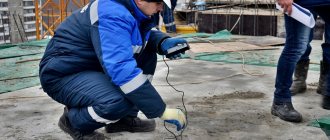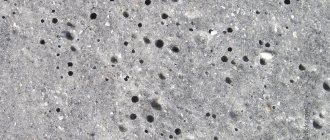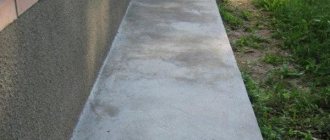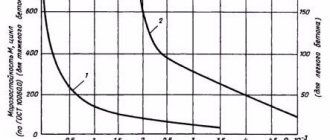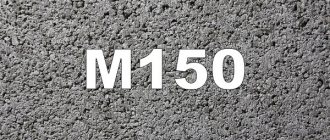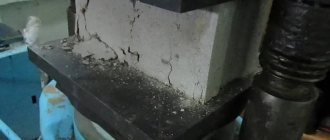The compressive strength of concrete (in MPa) is perhaps the main requirement for this solid building material. In accordance with its values, concrete is assigned a specific grade. For example, the designation “concrete m 200” indicates that after 28 days after production, its compressive hardness corresponds to 200 kgf/cm², in MPa – 19.6
Methods for testing concrete for strength are different. Thus, science knows destructive and non-destructive methods.
In the first case, testing of concrete for strength occurs in laboratory conditions by mechanical impact on prototypes that have been maintained for a specified period after hardening. Fracture is the most accurate way to study strength criteria. This is a mandatory experiment before putting the structure into operation.
The non-destructive method involves:
- Impact.
- Partial destruction.
- Ultrasound examination.
There are three types of impact:
- shock impulse;
- elastic rebound;
- plastic deformation.
The first is a rather primitive technique, which consists in recording the dynamic effect in energy equivalent. The second is even simpler: when the striker of the impact unit rebounds, the hardness parameters of the concrete are determined. The essence of the third is the processing of the test area with special equipment; the degree of strength is judged by the depth of the imprints left.
The following types of partial destruction are known:
- chip;
- separation;
- chip with separation.
During the first category of tests, the edge of the product is subjected to a sliding action in order to break off a part of it. In the second case, a metal disk is fixed to the surface using a special adhesive and then torn off. In the third, an anchor device is fixed to the structure and then torn off.
The ultrasonic examination method measures the speed of ultrasonic waves that penetrate the concrete layer. The advantage of the technology is its ability to study both the surface and the internal body of concrete. The downside is the large error of the data obtained.
What does strength depend on?
Concrete gains strength due to chemical processes occurring during the interaction of the concrete mixture with water. At the same time, the rate of chemical reactions under the influence of certain factors can accelerate or slow down, which directly affects the strength characteristics of the final product.
The main technological factors include:
- dimensions and shape of the structure;
- concrete shrinkage coefficient when pouring;
- degree of cement activity;
- percentage of capacity in the cement mixture;
- proportions in the cement and water solution used;
- types and quality of fillers used, and the correctness of their mixing;
- degree of compaction;
- solution hardening time;
- conditions under which curing occurs: humidity and temperature indicators;
- application of repeated vibration;
- conditions for transporting the solution;
- caring for a monolithic structure after pouring.
Each of these criteria determines the strength of concrete and the reliability of structures or individual structural elements built from it.
The strength characteristics of concrete may deteriorate if production technologies are violated. Examples of gross violations include exceeding the permissible time spent in transit of the concrete mixture, failure to compact and tamp during pouring, and others.
Application of suitable grades of concrete for various construction projects
When constructing objects using an industrial method, ready-mixed concrete is used, which has the following markings given in the table:
When producing high-quality ready-mix concrete, strict dosing of the components of concrete mixtures occurs. This serves as a guarantee of the strength and durability of future buildings.
The cost of ready-mixed concrete is determined by the composition and proportions of the components.
Ready-mixed concrete is widespread and is becoming even more popular due to its use in monolithic buildings and structures. The main differences between concretes - reliability, seismic resistance, absence of technological seams, uniform shrinkage and low price - determine their use:
- when pouring walls and foundations using formwork, which allows obtaining strict forms of given monolithic structures;
- when creating floors made of concrete or reinforced concrete, reinforced with steel frames, providing increased resistance to loads;
- during the construction of hydraulic structures, including the production of a variety of swimming pools of any size and level of complexity;
- when used as a cushion under the road surface when laying roads of different sizes;
- during the construction of various platforms, concrete blind areas, sidewalks and garden paths.
What is a class?
Concrete class is the guaranteed compressive strength load that it can withstand, measured in MPa (megapascals). This characteristic was introduced to clarify the properties of the frozen solution, since they may vary for one brand. This parameter allows you to determine its actual strength, as it is calculated for cases where it will be confirmed by at least 95%.
The strength class of concrete is designated by the symbol “B” with indices from 5 to 60, which indicate the value of the pressure in megapascals that the material can withstand before failure. This indicator correlates with a brand more familiar to builders.
Cone draft
The cone settlement is usually called data, which is also called the performance characteristics of concrete. This is the so-called plasticity in concrete, it is measured in centimeters. To explain it even more simply, the higher the cone draft, the more movable the product is.
This value is indicated in the technical documentation for concrete, denoted by the letter P, followed by a number in the range 1-5. But do not neglect knowledge about the cone settlement of cellular products. If monolithic construction operations are foreseen, then use material with data P2 or P3. If a structure with poor accessibility for filling with material is being poured, it is recommended to use product P4 and types with higher performance. Otherwise, such a solution is also called cast concrete. If it is necessary to carry out laying in formwork without the use of special vibrator equipment, then such a choice will be ideal. This mixture also behaves well when working with a concrete pump.
Methods and testing of concrete for strength
To determine the grade and class of concrete, a variety of methods are used - all of them fall into the categories of destructive and non-destructive. The first group involves conducting tests in a laboratory through mechanical action on samples that were filled with a control mixture and completely aged within the specified time frame.
- Impact impact.
- Partial destruction.
- Ultrasound examination.
The impact impact can be different - the most primitive is considered to be the impact impulse, which records the dynamic impact in energy equivalent. Elastic rebound determines the hardness parameters of the monolith at the moment of rebound of the drum striker.
The method of plastic deformation is also used, which involves treating the area under study with special equipment that leaves imprints of a certain depth on the monolith (the degree of strength is determined from them).
Types of foundations for a house
The choice of foundation type is entirely based on the strength characteristics of the soil, the topography of the site and the characteristics of the local climate, the presence of groundwater in the soil. In most cases, for the same object you can use not just one, but different types of base. Typically, designers calculate several options based on the estimated cost and make a choice based on economic feasibility.
Strip foundation
The entire process of designing foundations is based on mathematical calculations, and only after studying the properties of the soil in the area allocated for construction. This applies to the greatest extent to strip foundations, since spatially they are the most unstable and can not only sag, but also shift at the base and even tip over.
It is a thankless task to give unfounded advice on where such a foundation can be placed and where it cannot. Such a choice, without an accurate assessment of the situation and calculation, is like a lottery - and, as you know, few are lucky in it.
- However, in private housing construction, strip foundations are more often used, since sometimes you don’t even need to install formwork to fill it. When the width, depth and configuration of the tape section are correctly determined, it has excellent load-bearing capacity, which is very important for buildings constructed from heavy stone materials. Although cellular concrete is not very heavy, in order to avoid cracking, it is important for it to have a strong and static base.
- Foundation strips can be constructed from prefabricated concrete and reinforced concrete (FBS and UDB blocks) and masonry materials (layered rubble stone and solid clay brick). But the most reliable material is a concrete monolith - filled with rubble stone or a reinforced spatial frame. The last option is the most popular, since rubble stone is not affordable in every region.
Expert opinion Vitaly Kudryashov builder, aspiring authorAsk a Question
Monolithic foundation strips are more labor-intensive to construct than prefabricated ones, but they are better suited for gas-block houses, as they have the greatest rigidity. This is especially true for houses with a basement or ground floor: the monolith is airtight and allows you to create the most reliable waterproofing barrier. Due to the absence of joints that would need to be sealed, such tapes are even more economical.
- Under heavy loads and unstable soils, strip foundations are made not just as a rectangular wall in the ground, but can have a widening both at the base and at the base. A wide concrete pad at the base is needed to increase the support area. In the basement part, the expansion is carried out so that there is enough space to support the walls of the house with insulation and finishing, and at the same time it is not necessary to increase the width of the tape along the entire height.
- The widening in the sole can give the cross-section of the tape the shape of a T-bar or trapezoid, and it must also be precisely calculated. The protrusion of the sole relative to the vertical parts of the tape is made no more than 200 mm - so as not to provoke the occurrence of stress as a result of stretching.
- If there is a basement, a T-shaped tape is usually used, the horizontal part of which is located under the lower border of the floor. The height of the supporting heel is about 300 mm, the distance from its sole to the lower plane of the floor along the ground is filled with compacted sand.
- The normal laying of any foundation is considered to be when the base is lowered below the freezing limits of the soil. In Russia, even in the middle zone, UPG marks vary between 1.1-1.5 m, which largely depends on the type of soil. A tape of such a height cannot be economical in any way, because the volume of concreting is large, and besides, you also have to think about subfloors.
- This option is only advisable when building a house with a basement - without it, everyone tries to build small plots. This can be done, but here you also need an accurate calculation of the load of the house on the foundation. This option may be suitable for aerated concrete walls, but most likely it will also require widening at the base. It is impossible to fill a T-shaped tape without formwork, since the trench will have to be made not along the width of the tape wall, but along the width of its lower support.
When laying a foundation in a freezing zone, the bulk layers are increased in thickness to replace the weak soil layer and neutralize the forces of frost heaving. The ideal means to combat vertical and lateral heaving forces is to lay insulation under the sole of the tape and under the blind area. To understand what exactly needs to be done, you need to have the information that a preliminary soil study provides.
Monolithic slab
An option that does not create problems even in non-design construction is a monolithic slab - although, naturally, it is also necessary to calculate the load on the foundation. A solid monolith is suitable for almost any soil, including weak-strength, unevenly compressed and waterlogged soils. The likelihood of soil subsidence here is minimal, since the slab has a large support area and presses evenly.
Another advantage is the possibility of constructing a non-buried version, with only layers of sub-foundation pie (sand cushions, concrete, thermal and waterproofing) placed in the ground. The volume of excavation work and the costs of formwork are minimal, and coupled with the absence of the need to form a floor, the increased consumption of concrete and metal for the formation of a monolith is well compensated.
That's the entire volume of earthworks
When forming the foundation, combining the slab with a tape that acts as stiffening ribs allows you to reduce the thickness, which means saving concrete. The tape can serve as a support for the slab (when it is directed into the ground and located from below), and also, when placed on top of the slab, it can serve as a plinth. The ribs embedded in the ground not only protect the slab from possible shifting, but also take the lion's share of the loads on themselves.
This makes it possible to reduce the horizontal part of the monolith to 200-250 mm, while building codes provide for a minimum slab thickness of 500 mm. But here, of course, everything also depends on the specific loads. A slab with such a design works ideally for bending, and with proper drainage (after all, not only groundwater, but also surface water acts here), it saves houses from many problems in regions with a cold climate.
The disadvantage of slabs in houses without basements is the lack of space for placing communications, since pipes have to be laid in the living space, under the floor. Access to sections of pipelines running under the slab itself for repairs is limited, and spare lines have to be provided.
Such foundations are not built on permafrost soils because:
- In conditions of inconsistent heating, it is difficult to protect a slab from the effects of heaving forces.
- When frozen, any soil is strong, but when it thaws, its structural strength is lost. Additional supports in the form of piles are required, and this increases the cost of the foundation.
- You will have to lay a thick layer of insulation (at least 200 mm) under the slab, and this is also a considerable expense.
The problem with laying communications, as well as with ensuring the rigidity that aerated concrete walls need so much, can be solved by the option of a slab whose edges “look” upward. Their height is on average 30-40 cm, and this space, filled with compacted sand, is quite enough for laying any pipeline. A monolithic slab floor is poured on top, supported on the plinth, or beams with rough cladding and insulation are installed - and the floors of the house are reliably separated from communications.
The masonry rests on the stiffening ribs of the monolithic slab
Columnar foundation
Pillars are a variant of a point foundation. In addition to them, piles also belong to this category - they are similar in shape, so these two types of supports are often confused. The difference between them is the cross-sectional size, which is larger for the pillars, and the length, which is shorter for the pillars. Also, pillars can be erected from masonry material, while piles are always either piece driven or monolithic.
The height of the columnar supports is determined by the freezing limit of the soil. Their maximum height is 2.5 m (such supports can also be made with a shallow depth of 50 cm - however, not for an aerated concrete house). To create a reliable foundation for stone walls, a grillage is placed on the surface of the ground supported by pillars. It is this structure that takes the load from the weight of the building and evenly transfers it to the point supports.
Expert opinion Vitaly Kudryashov builder, aspiring author
Ask a Question
To form a grillage, ready-made factory beams can be used: ordinary window lintels with a rectangular cross-section, or rand beams with a trapezoid-shaped cross-section. But most often in low-rise construction they are simply poured over formwork.
In fact, the grillage is a variant of the ground foundation strip, and the same technologies are used in its construction. The only difference is that here the ring reinforced concrete beam rests not on the ground, but on pillars. Therefore, such a foundation is called a columnar-grillage foundation. It is one of the most economical options, but is not suitable for all construction conditions.
For example, columnar supports are not designed on highly subsiding and moving soils, on uneven terrain, when elevation differences exceed 2 m. This type of foundation is not suitable for forming a basement floor, as well as for heavy walls made of brick or concrete with brick cladding.
As in the case of a strip foundation, the height of the pillars can be reduced if widening is provided in the soles. To fill a monolithic pillar, you have to dig a pit under it of such a size that the person installing the formwork can fit in it. And in order to be able to move from one excavation to another, the pits are connected to each other by trenches that are small in width.
As an option, they immediately dig a wide pit. In both cases, the volume of excavation work will be greater than when installing a shallow slab. And the formwork has a rather complex configuration, especially when widening needs to be provided in the base.
For these reasons, columnar foundations, as such, are practically not used in private housing construction. More often, supports formed using bored technology are installed. People call them columnar foundations, but in fact they are not pillars, but piles.
Pile foundation
The main difference from pillars is the significant length of piles, which makes it possible to cut through layers of soil unsuitable for construction, no matter what their thickness. Accordingly, even in a flooded area or on peat bogs, you can drive piles deep, tie them with a grillage and build a house or any other object.
This is the only type of foundation that is suitable for any problematic soils: subsidence, swelling, soaking, permafrost. A pile foundation is not advisable only for rocky soils - it is difficult to drill into them, and there is no need, since the soil has excellent strength.
The optimality of this choice should also be confirmed by soil analysis. In addition, you need to take into account these data:
- seismic activity of the region;
- building design;
- terrain;
- availability of nearby buildings and communications;
- total loads acting on the foundation.
Piles are often combined with foundation strips or slabs, in which case they are reinforcing elements of the soil. These are the most expensive foundation options, but the conditions for construction are not at all favorable.
The main feature of the classification of piles is the methods of their installation:
- Driven piles include all variants of prefabricated reinforced concrete, which are installed in a pre-drilled well using mechanisms - not only impact, but also pressing and vibration. Such piles can have different cross-sectional shapes (not only a circle or a quadrangle, but also a trapezoid or a prism), and be hollow or solid. Based on the material, such piles can be not only reinforced concrete, but also steel and even wood.
- Screw piles include only those piles that have at least one blade and are installed by screwing into the ground. Made from reinforced concrete and metal. The second option is not very suitable for an aerated concrete house - except when the piles are tied with a reinforced concrete grillage. In this case, the pile cavities should be filled with concrete or sand-cement mixture and well sealed by welding plugs. Concrete screw piles are completely rare in private housing construction.
- Driven piles are supports installed in wells. Moreover, they are not drilled, but are formed as a result of forced extrusion of soil. There are several technologies that use mechanisms with different operating principles (displacement, vibration-stamping, etc.). The main difference is that concrete is placed directly into a ground well, without casing.
- Drilled piles differ from cast-in-place piles only in that concrete is laid in pre-drilled holes. The method is very convenient to use when passing through aquifers, when the walls of the well need to be immediately strengthened (for example, in soaking clay). For this, a casing pipe of a slightly smaller diameter can be used - a solution of bentonite clay is poured between its walls and the soil. Then the pipe is removed and the well cavity is concreted. There are at least 5 more technologies for constructing drilled piles, the difference between them depends on the type of equipment used.
We will not describe the features of the technologies - let’s just talk about those used in private construction. Basically, it is a combination of cast-in-place and drilled piles, which is called a bored foundation. To construct it, wells are drilled and filled with concrete directly into the ground. Alternatively, if the strength characteristics of the soil are weak or it is waterlogged, a permanent casing made of asbestos-cement pipes can be used.
Wells for bored supports lined with asbestos cement pipes
Such piles will have the greatest stability if they have a camouflage heel (widening in the sole), which makes it possible to slightly reduce the depth of installation. This widening can be done using a special device - a TISE drill. It has a folding bowl-shaped plow that fits onto the boom after the hole has already been drilled. This technology makes it possible to widen the base without developing a large pit or pit, which reduces the volume of excavation work to a minimum. The height of such a pile usually corresponds to the freezing depth, but cannot be less than 1.5 m.
The principle of pile formation using TISE technology
The piles should rise 20 cm above the ground level so that the heads can be monolid into the grillage. To do this, a formwork of 4 planks is installed around the well, with the help of which a continuation of the pile is formed. To simplify their task and do without formwork, many simply leave the reinforcement outlets of the required length. A casing pipe can also get rid of formwork. These are additional costs and each developer decides for himself whether to bear them or not.
Expert opinion Vitaly Kudryashov builder, aspiring author
Ask a Question
If there is a lot of snow in the region in winter, and the first floor of the house needs to be raised higher, it is more profitable to do this not by increasing the height of the grillage, but by using a large overhang of the above-ground part of the piles. In this case, it is much easier to form them using a casing pipe, or simply give preference to factory-made reinforced concrete products.
Class and grade of concrete in terms of strength, moisture resistance and frost resistance
The numerical designation of the concrete class expresses the measured strength of the sample in megapascals (MPa) and is designated by the letter “B”. The range of possible values includes values from 3.5 to 40. The most widely used brands have values from B10 to B40. For example, the B30 marking means that this building material is guaranteed to withstand test pressures of up to 30 MPa.
The brand is designated by the letter “M” and is measured in kg/cm2. The range of grades used includes concrete mixtures M50-M1000, which means an average strength in the range from 50 to 1000 kg/cm 2.
Brand and class correlation table
| Concrete class | Average strength (kg/cm 2 ) | Concrete grade |
| AT 5 | 65 | M75 |
| B7.5 | 98 | M100 |
| AT 10 | 131 | M150 |
| B12.5 | 164 | M150 |
| B15 | 196 | M200 |
| IN 20 | 262 | M250 |
| B25 | 327 | M350 |
| B30 | 393 | M400 |
| B35 | 458 | M450 |
| B40 | 524 | M550 |
| B45 | 589 | M600 |
| B50 | 655 | M600 |
| B55 | 720 | M700 |
| B60 | 786 | M800 |
Strength of concrete
Concrete strength is a key indicator of the load-bearing capacity of concrete. It is calculated experimentally by determining the compression limit of the material - the maximum load limit as a result of which the sample begins to collapse.
The design resistance of concrete to axial compression means its resistance to loading influences. This indicator is associated with standard parameters and is used during design calculations.
Until 2003, designers relied on material grades, but then a new classification was introduced. The grade of concrete for compression is denoted by the letter “M” and indicates the tensile strength expressed in kgf/cm 2, and the class of concrete is denoted by the letter “B” and is expressed in MPa.
The difference is not only in units of measurement. The main difference between the classifications is the guarantee of confirmation of the strength of the material. The grade indicates the average value, and the compressive class of concrete guarantees that in 95% of testing cases the specified strength is ensured, and the risk of deviation from the standard indicators is no more than 5%.
| Concrete strength class | Concrete grade | Average strength of concrete of this class (kgf/cm 2) |
| B7.5 | M100 | 98 |
| AT 10 | M150 | 131 |
| B12.5 | M150 | 164 |
| B15 | M200 | 196 |
| IN 20 | M250 | 262 |
| B22.5 | M300 | 302 |
| B25 | M350 | 327 |
| B30 | M400 | 393 |
Current standards are reflected in SP 52−101−2003 “Concrete and reinforced concrete structures without prestressing reinforcement.” Modern classification helps to design concrete and reinforced concrete structures with optimal characteristics.
Using average strength indicators (grade of concrete) carries the risk that the actual characteristics of the material will be lower than the calculated ones. If the average indicators are used as the lowest, for reinsurance, it is necessary to increase the size of the concrete structure, which leads to its noticeable increase in cost.
Standardization of indicators
Depending on where the mixture will be used, the concrete is classified into grades and classes, which allows you to order a commercial mixture of the required quality. Specialists have developed technological maps with the compositional composition of mixtures. Concrete is identified by its compressive strength 28 days after pouring the sample and hardening it at a temperature of 20 0 C.
Brand – the average numerical value of the breaking force of standard samples, measured kgf/cm2. In international standards, it is customary to denote the breaking load in MPa. This indicator has the index “B”; it does not indicate the average, but the absolute number of samples corresponding to the parameter. Downward deviations may occur in 5% of samples.
Class, brand, characteristics, application
| MPa class | Brand kgf/cm 2 | frost resistance | water permeability | Application of concrete mixture |
| B 7.5 | M100 | F50 | W2 | Foundation in dry soil, poured before concreting the base. |
| AT 10 | M150 | F50 | W2 | Floor screed, arrangement of garden paths |
| B12.5 | M150 | F100 | W2 | Subfloors, low-load foundation |
| B15 | M200 | F100 | W4 | Screed, foundations, blind areas, cesspools, settling tanks |
| IN 20 | M250 | F100 | W4 | Reinforced concrete beams and floor slabs, stairs |
| B22.5 | M300 | F200 | W6 | By dense reinforcement of thin-walled, high-rise buildings |
| B30 | M400 | F300 | W10 | Road and airfield pavement, hydraulic structures. |
Methods for determining strength: concrete compression testing
There are two methods:
- destructive;
- non-destructive.
The first method measures the minimum force applied to break cubes and cylinders that are cut, sawed or drilled out of whole products. The rate of increase in load force is constant. After the test is completed, the final value of such efforts is calculated.
In the second method of finding the required indicator, a given place is affected mechanically (impact, tearing, chipping, indentation, tearing with chipping, elastic rebound). The point of application of the device should not be on the edge or opposite the fittings. Next, find the result based on the expressed gradation.
You should not count on complete truthfulness; there is an error of up to 10% for each type of check.
Material quality
Adhesion refers to how well the cement stone adheres to the aggregate particles. In addition, the main qualities also include:
- frost resistance;
- waterproof;
- compressive and tensile strength.
When the material is at its design age, its strength characteristics can be judged by the latest parameters. Therefore, it is worth noting that during cooking it turns out to be heterogeneous.
Here is the correspondence of concrete grades and classes
Strength fluctuations are reduced with high-quality mixture preparation, as well as with a higher construction culture. Therefore, it is worth remembering that the manufactured material must not only have an average specified value, but also have an even distribution over the entire surface.
Class Definition
The above-described fluctuations can be taken into account in such an indicator as a class, which is understood as a percentage indicator of a property. For example, if it is indicated that a material has a strength class of 0.95, then in 95 cases and 100 it will have this indicator.
It is worth noting that according to GOST, the classification of concrete consists of 18 main classes of compressive strength indicators. In this case, at the beginning the name of the class is indicated as B1, followed by the numerical value of the tensile strength, displayed in MPa.
Frost resistance
The indicator is determined by the number of periodic thawing and freezing cycles and is designated by the letter F, with a numerical value of 25/50/75/100/150/200/300/400/500.
To implement frost-resistant concrete, it is necessary to use Portland cement and its types: hydrophobic, plasticized, sulfate-resistant, quick-hardening.
Active mineral components that increase the water demand of the binder in reinforced concrete cannot be added to cement. Frost-resistant material is created by ensuring the correct dosage of the constituent components.
The working solution must be thoroughly mixed and compacted. The hardening material requires proper care. For ripening, natural conditions are preferred, with positive temperatures and humidity maintained for 10 days.
Method for determining the strength of concrete
In the industrial production of concrete or reinforced concrete products, laboratory tests are carried out to determine the exact strength of concrete. Methods for determining strength are regulated by GOSTs and SNiPs. There are methods of destructive and non-destructive testing. The former are considered more accurate, but they cannot always be applied in practice.
This is due to the fact that destructive tests require the presence of an analyzed sample, which cannot be removed without compromising the integrity of the structure. Therefore, non-destructive methods are more often used, based on the analysis of readings from measuring instruments .
How to choose the type of foundation for a house
First of all, the choice of foundation type depends on the design of the zero cycle - namely, the presence or absence of a basement. The option with a basement is usually preferred by residents of rural areas and owners of summer cottages, because the premises under the house eliminate the need to build additional cellars or other premises for storing food. City dwellers often prefer the ground floor, where all the technical rooms can be located, as well as a laundry room, a sauna, a mini-gym - not to mention a garage, for which there is always not enough space for small plots allocated for individual housing construction.
Refusal of a basement is usually dictated either by its uselessness, or by the presence of contraindications related to the geological situation: increased groundwater level or extremely dense soil, the development of which is too expensive. If there are no such contraindications, only a strip or slab foundation can be used to form premises in the zero cycle.
In this case, in addition to the functions of the foundation, the tape will also serve as the walls of the basement. As for the slab foundation, the walls resting on it are simply enclosing structures. If they are monolithic, then they are combined with the stiffening ribs of the slab.
If in a house without a basement there is only a small space between the foundation slab and the basement floor, used for laying communications, then when the slab is recessed, full-fledged rooms are formed. However, in this case, as in all others, the geological situation must be taken into account.
Taking into account soil conditions
The soil is examined before design begins. The main goal of this action is to identify processes occurring in the soil that can be dangerous for the structures embedded in it (landslides, quicksand, suffusion, soaking). In addition, it is necessary to study the structure of the layers of the earth, their mechanical characteristics, degree of humidity and corrosiveness. The data obtained will help you choose the best option that is resistant to existing unfavorable factors, as well as calculate its economic feasibility.
The lack of a comprehensive analysis can lead to dire consequences - from the rupture of pipelines at the entrance to the building, and ending with the distortion or overturning of the house. For research, wells are drilled in the ground and samples are taken directly from the building site at at least five points: in the corners of the building and in the center.
Samples are usually analyzed in the laboratory, but can also be analyzed in the field. The latter option is most often used when it is necessary to construct a pile field, and makes it possible to determine the best way to immerse the supports.
In laboratories, samples are used to detect:
- soil subgroup in accordance with classification;
- formation composition, its physical properties and mechanical condition;
- uniformity in construction area and formation depth;
- standardized characteristics;
- the probability of changes in soil characteristics during construction and operation is assessed.
Each test is carried out three times, and the arithmetic average is taken as the result. Not only loose samples are studied, but also in the form of a monolith with undisturbed density. The laboratory evaluates their grain composition, density and strength, and percentage of moisture. The main test reveals the degree of soil deformation during compression, and it can be carried out in different ways - using a stamp, a pressure meter, a probe, a stabilometer. This depends on the type of soil, because it is often necessary to study not only the nature of deformation, but also determine the consistency of each layer.
One of the main indicators of soil is the amount of settlement - this is the difference between the initial position and the position after displacement under load. The calculation of the base of the foundation when it comes to strips or pillars depends on the results of this test. The designer's task is to assign dimensions to the foundation that will allow it to settle evenly, since it is uneven settlement that causes problems with cracking.
Even when the top layer of soil shows the same amount of settlement during testing, it will not bear the same loads equally. Therefore, when selecting a foundation or a combination of two structures, the design of the building, which may have variable heights, extensions and superstructures, is of considerable importance. This is a different weight - and therefore unequal loads that the soil must resist.
SP 22.13330 offers tables of calculated resistances for different types of soil, on the basis of which preliminary calculations can be made. But accurate data can only be obtained using actual indicators obtained in the process of studying the soil. The top layer of soil, in which water flowing from the surface can accumulate, is especially analyzed. The more pores there are in the soil, the more water it can collect - especially if there is an aquifer made of clay under the loose layer.
Ice formed at subzero temperatures takes up more space than water. By increasing the volume, it pushes solid, durable particles of earth to the surface, provoking swelling of the soil - and this occurs throughout the entire thickness of the frozen layer. To understand where the boundaries of the layer lie, you need to do more than just find out the average level of soil freezing in a given region.
It is necessary to determine the UPG depending on the type of soil, because not all of them freeze equally. In the same city, clay can freeze up to 130 cm, and coarse soil – up to 190 cm. And this is another reason to do a soil analysis before starting design.
Concrete grade by compressive strength
Along with the class, the compressive strength of concrete is determined by the grade. This value also directly depends on the proportion of cement in the finished material. Latin “M” with adjacent numbers indicating the limit of compressive strength in kgf/sq.cm - this is how concrete grades of corresponding strength are designated.
The concept of “grade” includes the average strength value, and the concept of “class” denotes the compressive strength of concrete with guaranteed security.
In the provisions of GOST, there are grades M50 - M800, which the produced concrete mixtures must comply with. The most common and most frequently used of them: M100 – M500.
Experts conditionally divide concrete of all manufactured grades into the following groups:
- M500 – M800 – concrete mixtures of cement and durable aggregates – heavy class concrete; M50 – M450 – concrete mortars with lightweight aggregates – lightweight concrete; M50 - M150 - cellular mixtures - the lightest type of concrete.
Thus, the strength class of concrete is determined by its grade, which, in turn, determines the place of application of the concrete. The lower the number, the lower the tensile strength. For example, it is advisable to use M75 concrete mixture for arranging blind areas, and M200 concrete for floors.
| Concrete class | Concrete grade | Concrete class | Concrete grade |
| B0.5 | M5 | B15 | M200 |
| B0.75 | M10 | IN 20 | M250 |
| IN 1 | M15 | B22.5 | M300 |
| B1.5 | M25 | B25 | M350 |
| AT 2 | M25 | B30 | M400 |
| B2.5 | M35 | B35 | M450 |
| B3.5 | M50 | B40 | M550 |
| AT 5 | M75 | B45 | M600 |
| B7.5 | M100 | B55 | M700 |
| AT 10 | M150 | B60 | M800 |
| B12.5 | M150 |
The correspondence of concrete compressive strength classes and corresponding grades are located in universal tables on the websites of cement manufacturers in Moscow. If such a table is missing, you can convert the concrete grade to class using a convenient formula: B (class) = [M (grade)*0.787)]/10
Cement brand
Reinforced concrete gains strength during the maturation process, so the builder must be confident in the quality of the cement used.
Portland cement grades – M200/300/400/500/600/700. This is a conventional value indicating its compressive strength in kg/cm2 . The required strength of concrete when using cement of the same brand can vary, which depends on the quality characteristics, maturation conditions, and material consumption.
The dependence of the concrete grade on the cement grade is shown in the table
| Concrete, M | 100.0 | 150.0 | 200.0 | 250.0 | 300.0 | 400.0 | 500.0 |
| Cement, M | 200.0 | 300.0 | 300.0/400.0 | 400.0 | 400.0 | 500.0 | 500.0/600.0 |

